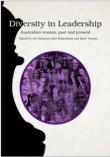AustLit
The material on this page is available to AustLit subscribers. If you are a subscriber or are from a subscribing organisation, please log in to gain full access. To explore options for subscribing to this unique teaching, research, and publishing resource for Australian culture and storytelling, please contact us or find out more.
Latest Issues
AbstractHistoryArchive Description
'Diversity in Leadership: Australian women, past and present provides a new understanding of the historical and contemporary aspects of Indigenous and non-Indigenous women's leadership in a range of local, national and international contexts. It brings interdisciplinary expertise to the topic from leading scholars in a range of fields and diverse backgrounds. The aims of the essays in the collection document the extent and diverse nature of women's social and political leadership across various pursuits and endeavours within democratic political structures. ' (Source: TROVE)
Notes
-
Contents indexed selectively.
Contents
* Contents derived from the
Acton,
Inner Canberra,
Canberra,
Australian Capital Territory,:Australian National University Press
, 2014 version. Please note that other versions/publications may contain different contents. See the Publication Details.
- Women’s Leadership in Writers’ Associations, single work criticism (p. 269-280)
Publication Details of Only Known VersionEarliest 2 Known Versions of
Other Formats
- Also e-book.
Works about this Work
-
Diversity in Leadership: Australian Women, Past and Present : Review
2016
single work
review
— Appears in: Australian Historical Studies , vol. 47 no. 2 2016; (p. 337-338)
— Review of Diversity in Leadership : Australian Women, Past and Present 2014 single work criticism biography 'This is a very impressive collection that throws new light on both Australian leadership and the nature of ‘leadership’ itself. The feminist insights driving the project have resulted in the uncovering of much-neglected histories of women’s leadership. They have also led to the editors and authors developing conceptions of leadership that, as Joy Damousi, Mary Tomsic (11–13) and Amanda Sinclair (19–20) point out, go beyond ‘alpha male’ conceptions based on macho, militaristic conceptions of outstanding individuals leading at the front, in order to incorporate alternative leadership attributes such as the importance of facilitating and nurturing the contributions of others. Indeed, as Marian Sawer and Merrindahl Andrew note, some 1970s feminists were initially very wary of the term ‘leadership’, seeing it as an inherently hierarchical and patriarchal conception that discouraged female empowerment and consensual decision-making (283). By contrast, this collection draws on more contemporary views which see leadership as a concept that can be transformed in positive ways, and the editors and contributors rightly argue that the varied forms of women’s leadership are deserving of far more recognition than they have been given so far. Nonetheless, as Jane Elix and Judy Lambert establish, women involved in movements such as the environment movement are still sometimes hesitant to claim leadership status for their outstanding records of activism (305), perhaps partly because of the power relations underlying the way in which some ‘leaders’ behave. ...'
-
Diversity in Leadership: Australian Women, Past and Present : Review
2016
single work
review
— Appears in: Australian Historical Studies , vol. 47 no. 2 2016; (p. 337-338)
— Review of Diversity in Leadership : Australian Women, Past and Present 2014 single work criticism biography 'This is a very impressive collection that throws new light on both Australian leadership and the nature of ‘leadership’ itself. The feminist insights driving the project have resulted in the uncovering of much-neglected histories of women’s leadership. They have also led to the editors and authors developing conceptions of leadership that, as Joy Damousi, Mary Tomsic (11–13) and Amanda Sinclair (19–20) point out, go beyond ‘alpha male’ conceptions based on macho, militaristic conceptions of outstanding individuals leading at the front, in order to incorporate alternative leadership attributes such as the importance of facilitating and nurturing the contributions of others. Indeed, as Marian Sawer and Merrindahl Andrew note, some 1970s feminists were initially very wary of the term ‘leadership’, seeing it as an inherently hierarchical and patriarchal conception that discouraged female empowerment and consensual decision-making (283). By contrast, this collection draws on more contemporary views which see leadership as a concept that can be transformed in positive ways, and the editors and contributors rightly argue that the varied forms of women’s leadership are deserving of far more recognition than they have been given so far. Nonetheless, as Jane Elix and Judy Lambert establish, women involved in movements such as the environment movement are still sometimes hesitant to claim leadership status for their outstanding records of activism (305), perhaps partly because of the power relations underlying the way in which some ‘leaders’ behave. ...'
Last amended 14 Dec 2016 08:27:39
Export this record




